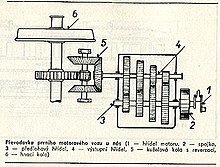ČSD series M 220.1
| ČSD series M 220.1 | |
|---|---|
| Numbering: | M 220.101-105 |
| Number: | 5 |
| Manufacturer: | Severočeská Vagónka Česká Lípa |
| Year of construction (s): | 1926 |
| Retirement: | before 1945 |
| Axis formula : | (1A) '(A1)' |
| Gauge : | 1435 mm ( standard gauge ) |
| Length over buffers: | 18,270 mm |
| Trunnion Distance: | 12,670 mm |
| Bogie axle base: | 2,500 mm |
| Service mass: | 42 t |
| Top speed: | 50 km / h |
| Installed capacity: | 112.5 kW |
| Driving wheel diameter: | 880 mm |
| Motor type: | DWK |
| Motor type: | 6-cylinder gasoline engine |
| Power transmission: | mechanically |
| Seats: | 16 (2nd class) 62 (3rd class) |
| Classes : | 2nd / 3rd |
The vehicles of the M 220.1 series were four-axle benzene-mechanical railcars for local rail traffic of the former Czechoslovak State Railways (ČSD). They were among the first types of motorized railcars of the ČSD.
history
The railcars were built in 1926 by the Böhmisch Leipa wagon factory (Severočeská Vagónka Česká Lípa) in five copies. They were among the first ČSD motorized railcars.
Cars 03 and 04 were used on the Častolowitz – Reichenau local railway on the Kněžna – Solnitz in Eastern Bohemia . They completely replaced the steam operation in passenger traffic, which was carried out in mixed trains with goods transport. With the use of the railcars, the maximum speed was increased from 25 to 40 km / h. In 1932 they were replaced by the M 120.423 and 424 and delivered to Hradec Králové . There the vehicles retired between 1936 and 1938.
Cars 01, 02 and 05 ran as an express train on the Reichenberg – Gablonz – Tannwald line (Liberec – Jablonec – Tanvald) to reinforce the traffic peaks during the hiking season . After the Sudetenland was annexed to Germany in autumn 1938, these vehicles came to the Deutsche Reichsbahn . There they were given the road numbers 136 410 to 136 412.
All five vehicles were retired by 1945. In Čelákovice is superstructure of M survived 220,104. It belongs to the collection of the National Technical Museum in Prague .
technical features
The vehicles were powered by a six-cylinder in-line gasoline engine from Deutsche Werke Kiel (DWK). The power was transmitted mechanically via a gearbox. With an output of 112.5 kW, the railcars reached a top speed of 50 km / h. The chassis consisted of two two-axle bogies.
When delivered, the railcars had room for 16 people in 2nd and 62 passengers in 3rd class. Later the 2nd class compartment was converted into 3rd class smokers . In the vehicles, the smell of gasoline in the passenger compartment was perceived as particularly disadvantageous.
See also
literature
- Andreas Knipping, Ingo Hütter, Hansjürgen Wenzel: Locomotives "Heim ins Reich" , EK-Verlag, Freiburg 2009; ISBN 978-3-88255-131-0 .
- 110 Let Častolowitz-Reichenau , SAXI-Verlag, 2003
Web links
- Website about the railcars of the series M 220.1 (Czech)
- Dimensional sketch on Výkresy železničních vozidel
- Photo of a railcar in Rychnov nad Kněžnou on k-report.net
Individual evidence
- ↑ 110 let Častolowitz-Reichenau p. 48
- ↑ Website for the M 220.1 series railcars
- ↑ Website about the existing car body of the M 220.104 on k-report
